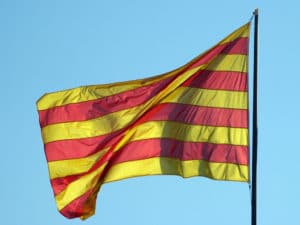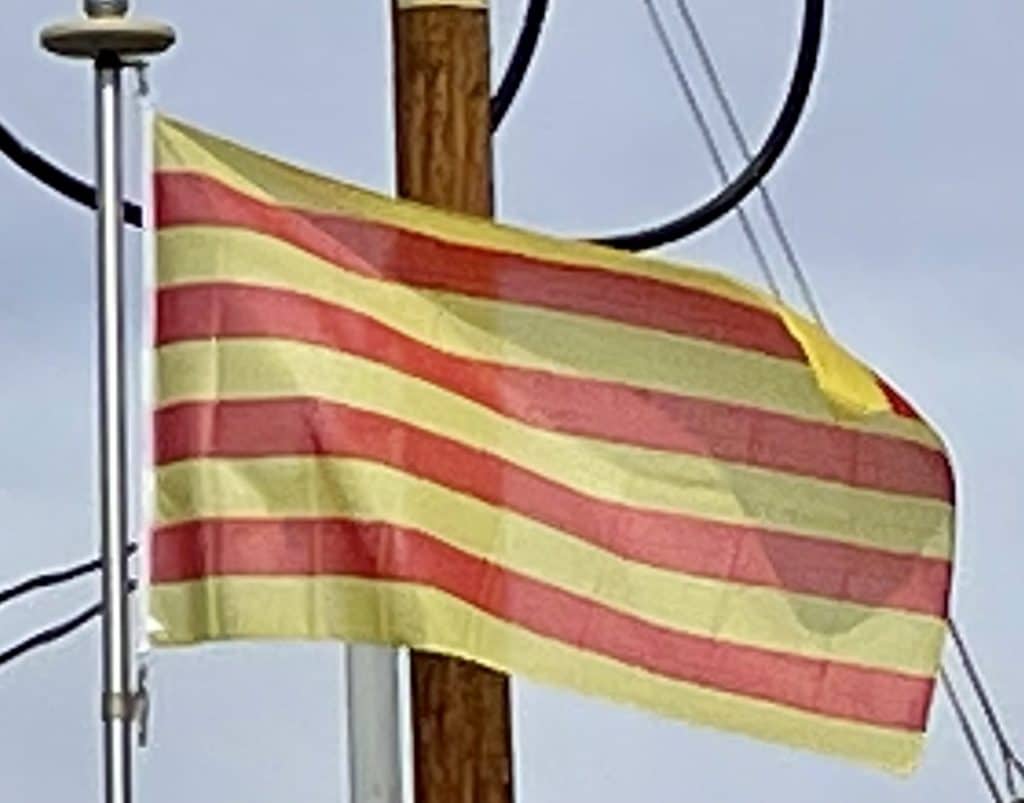Furthermore, the Pennon of the Conquest of Valencia is documented as the world’s oldest extant flag, dating from 1238, even though the yellow part was originally white, but the red stripes design was the same.
The Government of Catalonia states about its official symbols that it may derive from 11th century or 12th century pre-heraldic symbols and the County of Barcelona‘s coat of arms, in which the yellow and red bars were vertical, while horizontal in the flag. The dynastic coat of arms became also the one for the lands ruled by the counts. It is thus present in the flags and shields of the territories that once were part of the Crown of Aragon and also in the arms of Andorra, Provence-Côte d’Azur and Sicily among others.

Another version is that the Kingdom of Aragon used and adopted the colors of the Papal States in their own coat of arms as a public and notorious submission to the Pope, something which the County of Barcelona would have followed shortly after according to this version. The colors for the city of Rome, which in those times was controlled by the Pope, were the same. According to the Encyclopædia Britannica, the flag of the Holy See‘s Navy from the 12th century on consisted of two vertical red and yellow bands, sometimes bearing the tiara and the keys. According to the Vatican official website, the yellow and red of the flag of the Holy See were two colors traditional of the Roman Senate and People. This ancient flag can still be seen on the Capitoline Hill in Rome, near the Roman Forum. The Papal States changed its colors in 1808 to the present yellow and white, while the City of Rome sticks to the old colors to this day. We can reject this theory based on the works of Geronimo de Blancas, chronicler of the Kingdom of Aragon, 1585. This author reports that Pope Innocent III after crowning the King Pedro II (the Catholic) accepted that Aragon was a tributary kingdom of the Apostolic See. To compensate for this gesture the Pope appointed King Peter II Gonfalonier of the Church and that the Church’s banner had the colors of the crown of Aragon.
The Almogavars of the Catalan Company used a royal pennon with the arms of the Kings of Aragon when campaigning in the Byzantine Empire. It was used as ensign of the Aragonese Navy from 1263 to 1516.
The plain version of this was used as official flag of the Autonomous Community of Catalonia during the Second Spanish Republic and since the Spanish transition to democracy. In its plain version, it is also used in the French département of Pyrénées-Orientales (Northern Catalonia), part of the former Principality of Catalonia until 1659. It is also used as the flag of Provence, a distinct region with historic ties to the Counts of Barcelona and the Crown of Aragon.
The senyera pattern is nowadays in the flag of four Spanish autonomous communities: without any change for Catalonia, and, with variations, for the territories of the former kingdoms of the Crown of Aragon: Aragon proper, the Balearic Islands and Valencia (while the latter two are modern interpretations, the Valencian Senyera Coronada does originate back to medieval times). It also forms the basis of various unofficial versions, such as the blue or red estelada used by Catalan independence supporters.
